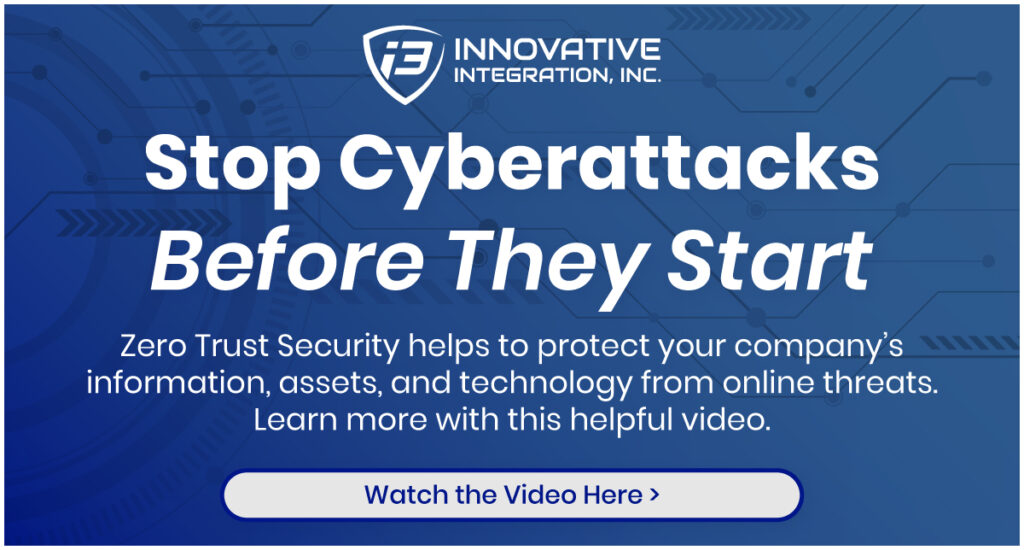Businesses looking for cybersecurity that consistently protects and monitors user activity often look to Zero Trust security. As a system designed to be suspicious of all users, a Zero Trust environment limits more potential threats and/or damage to network data than other structures on the market. So, what programs are needed to integrate this security model into your system? Let’s examine the steps to building such an advanced Zero Trust environment.
Is Your Company Ready for Digital Transformation?
Zero Trust Environment: Explained
Zero Trust is a strategic cybersecurity structure which requires all users—inside and out of the organization’s network—to be routinely authenticated, authorized, and confirmed before gaining access. In a Zero Trust environment, every device and individual is considered guilty until proven innocent. Designed to protect a company’s digital infrastructure, a Zero Trust environment uses a series of authentication checks—such as privatizing data access, segmenting information, and layering threat detection—to deter potential hackers by using advanced data security.
The reasoning behind a Zero Trust environment is that trusting devices under the notion they operate within the “corporate scope” of connection doesn’t matter in the war with cybercriminals; no device connection or permission is implicitly “safe” just because it’s familiar. Rather, the familiarity and seamless interconnectivity between Wi-Fi routers, cloud storage systems, and other devices exposes these systems to more external threats. Hence, a Zero Trust environment enforces multifactor authentication to constantly challenge and reassess authorization to approved personnel and devices. With every check-up, a Zero Trust environment examines the health of your company’s cybersecurity to the slightest detail.
Building the Environment
Implementing a Zero Trust environment into a business’ network requires a complete digital transformation. While automated software is standard for Zero Trust security, the rise of cyberattacks in the past few years has prompted new compliance mandates from the Federal Government. Outlined in Executive Order NIST 800-207, businesses seeking to create a zero trust environment must comply with federal guidelines.
Identify Visible Assets
Within a Zero Trust environment, your company must identify all network devices, connections, and applications. Since the baseline of Zero Trust security requires a routine survey of all systems, any network keys and devices must also be reviewed. For example, if your business uses Microsoft Outlook for email correspondence, then the app must be installed and used on employee devices rather than visited on the internet. By restricting user access through separate approved apps, companies can monitor user network activity, prevent potential cross-contamination of viruses, and use the internet out of reach from hackers.
Routine Access Verification
Zero Trust environments are designed to deny all network access. Whether or not users have proven trustworthy before, Zero Trust security automatically challenges authentication. This authorization can be checked either by secondary network keys, multifactor authentication on separate devices, or by sending a request to network supervisors. While constantly verifying users’ identities can be tedious to employees, implementing the “least access” to your organization’s data ensures all information access comes from the right locations.
Imagine an instance where an imposter requests access to your network through an unfamiliar device. Since a Zero Trust environment monitors login activity, hackers trying to imitate employees are easily caught when unable to validate online activity through proper codes or approved devices. In response, the Zero Trust environment software isolates the imposter, shuts down connections from their network location, and alerts IT personnel to remove the infiltrator.

Damage Control
Having cybersecurity may improve protection for your business data but it doesn’t necessarily make your information invulnerable to attack. By the time most organizations are alerted, cybercriminals will have likely stolen enough to damage your productivity. In a malicious attack, a Zero Trust environment not only alerts IT support but tries to isolate activity by shutting down network traffic to locate the invader. Although a Zero Trust environment can’t undo the damages from a breach, its segmentation of programs and files helps to limit further data corruption or collateral damage. Within the cybersecurity war, it’s crucial that any Zero Trust environment has damage control protocols in place to limit losses.
Automate Threat Response
Automation is a key requirement to maintain control throughout a Zero Trust environment. Without routine upgrades, real-time monitoring, and adaptations to new information, it’s impossible to integrate Zero Trust security into your business. Therefore, automated rapid controls have been mandated in the hopes that companies can rapidly respond to threats and adapt procedures without affecting productivity. By integrating automated response in a Zero Trust environment, companies can free IT to focus on other projects, placing their attention on repairs only as needed throughout the workday.
Create a Zero Trust Environment with Digital Transformation Software
A Zero Trust environment is more than just restricting network activity: it’s about creating a safer digital space for businesses with the right protection. By automating and tracking company applications, a Zero Trust environment helps regulate who may access your company’s sensitive data. By implementing the new NIST policies to verify network access, organizations with Zero Trust security can quickly adapt their workflow procedures, thereby limiting exposure to dangerous malware or hackers. To create a Zero Trust environment, though, Digital Transformation software must be installed to upgrade programs to current NIST policies.
From multifactor authentication to mobile device management, Innovative Integration offers many programs to customize your company’s Digital Transformation. Interested in creating your Zero Trust security infrastructure? Visit Innovative Integration and learn more about our services.





